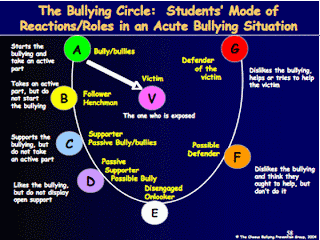Bullying is an ever growing problem in schools. It happens at every level, elementary, middle, and high school. However, as the problems with bullying are on the rise, the understanding of bullying and the different roles involved in bullying is less and less. There is a lot more to bullying than one student saying something unkind to another. Bullying (as it happens in schools) is defined as unwanted, aggressive behavior among school aged children that involves a real or perceived power imbalance. The behavior is repeated, or has the potential to be repeated over time. For an event to be considered bullying, the behavior must be aggressive (this is NOT limited to physical aggression), and there must be an imbalance of power, which means using power in terms of physical strength, access to embarrassing information, or popularity to control or harm others. It is possible for power imbalances to change over time and in different situations, even if they involve the same people. Bullying behavior must also be repetitive, meaning it happens more than once or has the potential to happen more than once.
There are typically three types of bullying: verbal bullying, which is saying or writing mean things about someone else, social bullying (aka relational aggression), which is damaging someone else's social relationships by embarrassing them, spreading rumors, leaving them out, etc., and then the more traditional physical bullying that most people picture when bullying comes up as a topic of conversation. Often, in a situation where bullying is happening, more than one of these types of bullying are happening at the same time.
When a bullying situation is happening, there are several people involved. It is not just the student or group of students doing the bullying vs. the student or group of students being victimized. There is an entire circle of people that are typically involved in the bullying. Obviously, not every situation is the same, but in general, those involved typically include the bully and the victim, followers, supports/passive bullies, the disengaged onlookers, possible defenders, and then those bystanders who are active defenders. The image below shows what the bullying circle usually looks like:
I think it is so important to teach students the power of the bystander. There are two things that people can do as bystanders in a situation. They can just watch as the bullying continues and things get worse for the victim, or they can take an active role by standing up for the victim. That can mean actually speaking to the bully/bullies and letting them know that they need to stop, or it can mean going to get the help of a teacher, counselor, or principal. Intervening in a bullying situation is the best way to make it stop.
Too often, bullying is ignored. That is the advice children often get as well. How many of you have ever heard or said "Just ignore them and they'll stop eventually." Sometimes, luckily, that is true. Other times it's not. Bullying can be relentless for some students. As we have seen over the past several years, the ramifications for victims of bullying can be very serious. As educators and parents, the best way to ensure that we improve bullying is to make students aware that there is a zero tolerance policy for bullying, being consistent with the handling of students who bully, and educating students on what to do if they are being bullied of if they see someone being bullied. As the adults in the school, our most important job is to make sure that students are safe. We are the biggest defenders of all, and we must practice what we preach in terms of standing up for the victims of bullying.
For more information of bullying, and what constitutes bullying, please visit stopbullying.gov.
PPBF: Broken
1 day ago



No comments:
Post a Comment